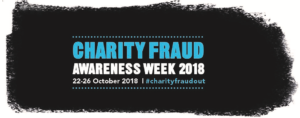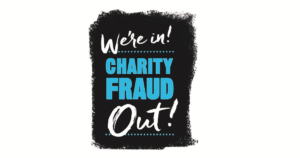Charity Fraud Awareness Week – Let Us Show You How
Day 2
As we confirmed yesterday this week we are supporting Charity Fraud Awareness Week by sharing great advice and resources provided by organisations such as the Fraud Advisory Panel and the Charity Commission we are running our ‘Let us show you how’ campaign each day this week. If you missed our Day 1 post you can catch it here.
What does this mean?
Each day there will be great content and resources with some great advice – we are going to ‘show you how’ to convert that in to practical action that does not require any prior knowledge of managing fraud risks. We will ‘show you how’ you can integrate effective fraud risk management into your other risk management processes, compliance programs and operational procedures.
Each day we will provide a 5 minute digest to prompt discussion and challenge organisations to identify an action they are going to take to move things forward. By the end of the week you will therefore have 5 practical things you have pledged to do. If you choose to share those with us we can also send you a reminder each quarter to check how you are getting on.
Day 2 focus is on knowing your beneficiaries, staff, donors and partners (due diligence) and creating a counter fraud framework
Knowing your beneficiaries, staff, donors and partners (due diligence)
I am so excited that this has come up as a topic, firstly because grant fraud is where I cut my fraud teeth some 25 years ago, and secondly because of the amount of guidance and resources that are out there to help you with this. Why – because due diligence i.e. understanding who you are paying (whether a beneficiary or a supplier) is the key to preventing all different types of fraud not just grant fraud (check out the Fraud Advisory panel grant fraud checklist ), but also employee theft, supplier frauds, terrorist financing and of course money laundering.
As we say there is so much guidance out there such as the Charity Commission Chapter 2 of its Compliance Toolkit. We are not going to attempt to repeat all of that here, but we thought we would add our own perspective on the key aspects, provide some practical resources and steps and also seek inspiration from across other sectors:
Our Top Tips
- From a money laundering perspective the banks, accountants and solicitors have all struggled with the Client Due Diligence and source of funds checks and that is why there is so much guidance out there from other regulators. So why not learn some of the lessons from the mistakes of some of those sectors that have been most heavily regulated from a money laundering perspective and then apply that to all your different due diligence work. The good news is you don’t have to do that work as we have done it for you and condensed that in to our screening/due diligence section of our guidance and resources in our free self serve resource centre. Again there is so much in there that we cannot possibly cover it in a single blog but we have set out below a few key nuggets to get you thinking.
- Make sure your processes across all the different risk areas where you perform checks on individuals or businesses are consistent thus achieving some economies of scale. Many of the banks are only just realising that the people they have working in silos on bribery checks, money laundering checks, customer checks, and modern slavery checks are often asking the same questions and seeking the same information from the same people!
- When looking at country risk include the country risk lists for bribery and corruption provided by Transparency International, also check out the list by TRACE International as this can point to more specific business related bribery risks that can inform a more specific risk assessment. Although some of the TRACE services require payment the country risk assessment is free. Also check out the country by country assessments provided by the Global Slavery Index.
- When checking the identity of individuals remember you need to verify that identity documents are genuine and that the holder of the document is the person who the document relates to. The Home Office has produced guidance on manual checking identity documents and there are also technical solutions out there too.
Creating a counter fraud framework
Taking an holistic approach across the organisation and combining proactive and reactive work is the key to successful counter fraud work and is at the heart of our resource centre.
- If you would like to know more about our resource centre then please check out our video and information here.
- If you would like to find out more about our holistic approach to fraud risk management then please check out our video here.
- We have also developed an organisational self assessment checklist which enables you to self assess against each element of the counter fraud framework as well as the Charity Commission 10 questions on fraud.
This toolkit has been developed specifically to accompany the guidance and resources contained on this website. It can also be used as an audit tool to assess your charity’s capability against defined standards taken from best practice across public, private and not-for-profit sectors.
![]() By completing the self assessment questionnaire the tool will also auto-complete an assessment against The Charity Commission 10 questions on fraud.
By completing the self assessment questionnaire the tool will also auto-complete an assessment against The Charity Commission 10 questions on fraud.
The tool therefore provides charities with benchmark reports against internationally recognised standards as well as Charity Commission recommendations and includes a dashboard for visually reporting the outcomes of the assessment.
How do I get more ‘Let Us Show You How’ information?
There a 3 easy ways:
- We will be posting updates on our website during fraud awareness week so simply visit our news feed each day, or
- Follow us on the usual social media platforms using the buttons at the top of the page, or
- Subscribe to our special mailing list using the contact form below and we will deliver the content direct to your mailbox each day.
What next?
Each day we also said we would challenge organisations to identify an action they are going to take to move things forward. By the end of the week you will therefore have 5 practical things you have pledged to do. If you choose to share those with us we can also send you a reminder each quarter to check how you are getting on. So what will you choose – one of the actions identified by the Charity Commission or perhaps check out one of the country risk links above, or complete our fraud framework self assessment review? The choice is yours….!
We will be liking and retweeting other posts so please join us in keeping #charityfraudout.
To get our daily updates all this week please sign-up to our special email below.





Comments are closed.